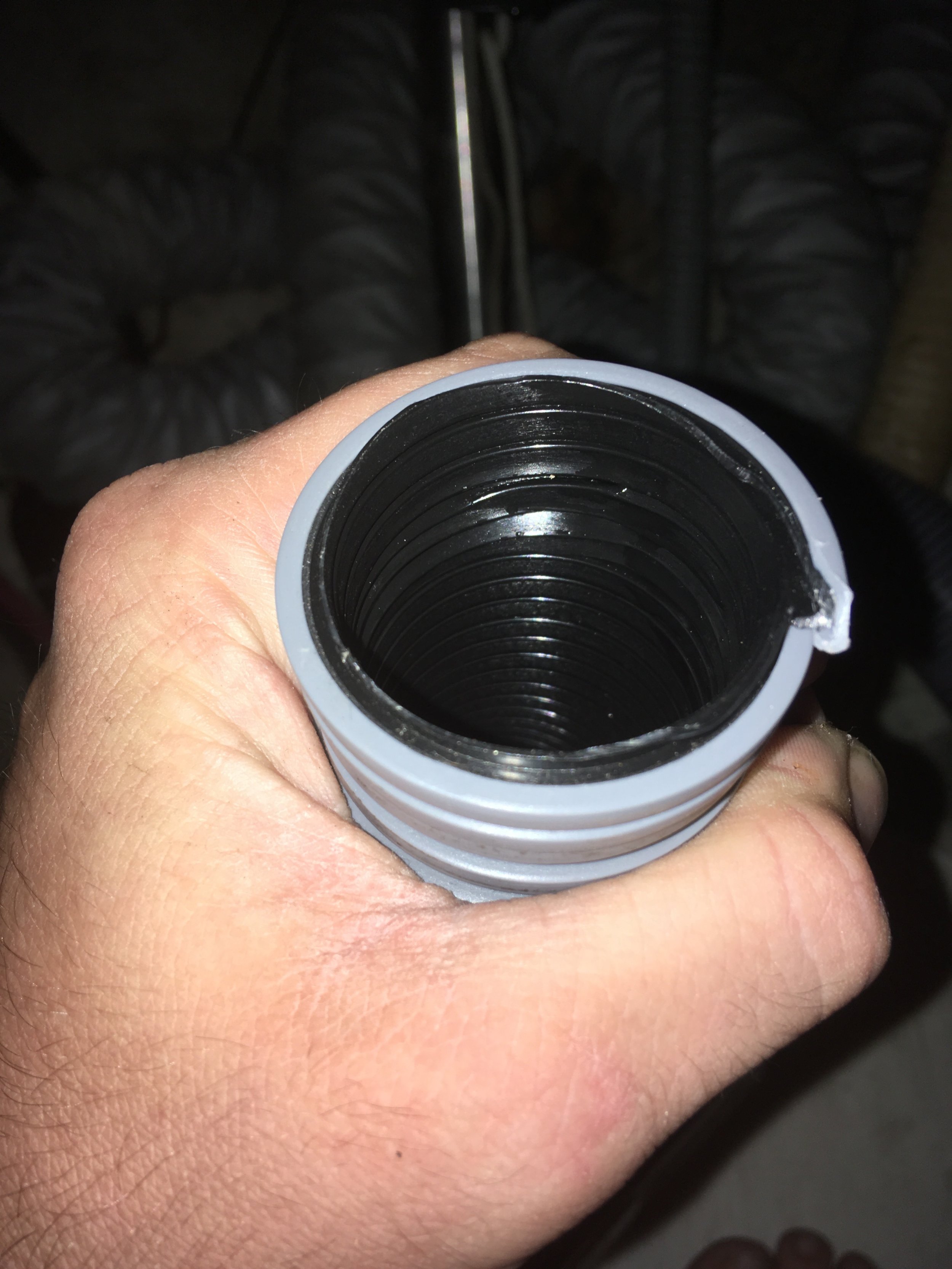When you finish a wooden project, you may be thinking of painting it to match the rest of the boat, but there is another and more beautiful option: Varnish.
Varnished wood is often used as accents on a yacht to breakup the constant and endless white that is the typical yacht deck. These accent pieces are referred to as "bringhtwork" in reference to the old varnished or bare metal sections on wooden boats.
Metals used to tarnish very quickly and antique vanishes were not as durable, so the act of maintaining these accent pieces required constant work and was a beacon of constant maintenance to all other yachties. As technology progressed, the qualities of the metals used on a yacht improved and required less maintenance to maintain them "bright". Stainless steel, which will remain shinny with very little effort replaced bronze, bronze which will tarnish quickly in the marine environment. Wood coatings also improved, allowing coatings to last longer and require less maintenance, even in tropical latitudes. Overtime, exposed metals became less of a point of interest and brightwork has come to simply refer to well maintained wooden accent pieces on a yacht.
Naturally, the opposite choice is to simply paint the wooden project you have finished and hide all the woodwork behind a layer of pigment. If you decide to showcase the beauty of your woodworking skills, finishing bright will be the way to go!
Should you decide to finish your project bright, you first need to decide on a coating material to use. There are two main camps that exist for brightwork: Varnish and Polyurethane.
When most people speak of varnish, they are actually referring to polyurethane. Most stores have shelves full of polyurethane in the varnish section and you will have to search to find the one can of varnish they have stuffed down on the bottom shelf. The shift to polyurethane is a logical one.
Polyurethane is the progression of technological advancements, containing better UV inhibitors in the material that will allow the coating to survive for longer in a the harsh marine environment. Polyurethane coatings will survive many years without maintenance while they are beaten by the sun, salt, and rain. This makes them a favorite amongst do-it-yourself types because it applies easily and last a long time.
While it might seem like polyurethane is an obvious choice, it does have its drawbacks for the wood itself. Polyurethane is nothing more than liquid plastic that covers the wood. It goes on top of the wood and forms a plastic shell over the woodwork, isolating it from the outside world. Polyurethane will stand up to the elements for a period of time, until the plastic molecules finally break down and peel off the wood in large pieces. At this point, the polyurethane needs to be stripped off completely and started over fresh. This is a very labor intensive job which tends to give brightwork a reputation of being beautiful for a while, which will turn to ugly and expensive to restore.
While polyurethane is a popular choice because it goes on easily straight from the can and looks beautiful for a while, it doesn't do much for the wood that it is trying to protect.
The wood beneath the plastic layer is sitting there in a very unhappy state. While the wood may look beautiful from the outside, inside, the wood is neglected and unprotected. Wood is a collection of lignin arranged in a series of rings and tubes. These rings are the annual rings of the tree, and the tubes are the passage ways that the tree used to transport nutrients within the plant. When wood is used to build something, it is usually very dry, meaning devoid of water and moisture. Wood warps and splits in relation to the orientation of the rings in the wood. To avoid this, the moisture content in the wood needs to be maintained at an even level.
For indoor furniture, the wood is simply maintained dry. On a boat, dry is only a pipe dream! The wood will be exposed to water and it will absorb this water through the tubes. This will make the wood wet and happy until the sun beats down on the wood, causing the wood to dry out in a hurry. This rapid change in moisture content will cause the wood to check, or form those little cracks that run perpendicular to the annual rings of the tree.
When you coat brightwork in polyurethane, you are encapsulating the wood in plastic. Since the dry wood lives in a plastic tomb, you might think it is all fine, but the wood will still absorb water over time. Overtime, the wood will begin to decay and degrade from its hard life of sitting in water.
At this point, you might be wondering why is polyurethane so popular? It coats the wood in a plastic casing that does nothing to keep the wood happy and it requires a lot of work to restore the finish when it finally fails. You have to look no further than money when it comes to choices of finish materials. There is a lot of money in creating proprietary chemicals that look great when first applied, and not as much money in canning more old varnish. By creating catchy names and paying to have their products placed on the good shelves in stores, polyurethane has taken a strong hold on the market as the memory of real varnish slowly drifts away.
Varnish, the other option for wood finishing, is made out of resin, drying oil, and solvent. Modern varnishes have added UV inhibitors which make them last longer in the tropical sun. Varnish, unlike polyurethane, contains oils that will soak into the wood and help fill the pores in the wood to keep the wood's moisture content stable. While it may seem like varnish is the obvious choice to coat wood and keep it happy as it endures its life as an accent piece on the deck of your yacht, but it is not that simple. Varnish can be applied over bare, dry wood, with the same end result as applying polyurethane over the same wood; just that the varnished wood will be slightly happier as it has been feed oils that would have soaked into the wood during the application process. The inside of the wood will still be dry and moisture will still enter and exit the wood through the varnished coating. The only other benefit of varnish vs. polyurethane is the varnish will be easier to maintain over the years.
Where polyurethane will fail in large unsightly chunks of plastic that peel off the wood and drift out to sea, adding to the global plastic pollution problem, varnish will chip off in small portions. These small areas can be lightly sanded to remove the flaking portions and then coated in a new layer of varnish. That is all, just lightly sand the area and apply another coat. You won't have to strip it all off and start again, nor spend a lot of money to restore the finish.
While it might seem that polyurethane and varnish are about equal at this point, we have only been discussing the quick and neglectful way to finish bright work. If you want to really make it shine in a way that will last for years on end, you will have to take a few more steps.
A friend of mine who restores wooden yachts told me his secret: Raw organic linseed oil. It seems that each expert has their own differing way to finish bright work, the end result is a gorgeous result. If you ask a local pro, they will probably give you a different sequence of materials, and it is up to you which one sounds like something you would want to do.
According to my friend, you simply sand the wood to clean it and finish the wood with a smooth surface. Then you coat it in a liberal coating of raw organic linseed oil. The wood will drink up this oil as it is dry and thirsty. After a few days, the coating will dry, and you will simply apply another coat of raw organic linseed oil. This process will continue as the wood soaks up the oil until it finally reaches the point where it wont drink up any more oil. When the wood is saturated with linseed oil, you can then begin to varnish the wood. Since the wood is no longer thirsty, the varnish will not be drunk up into the wood.
This method is very easy to do, because all you need to do is oil the wood without sanding between coats and then varnish right after without sanding between coats.This makes the process of coating easier since you don't need to sand between coats.
While this method may seem simplistic, it is also very good for the wood. The wood will soak up the oil until it has become saturated. This means that it is no longer dry and will be less likely to absorb water when it gets wet. Since it is filled with oil, it also wont dry out when exposed to the harsh sun on dry days. This makes the wood much more stable from a moisture content stand point.
When the varnish on the surface begins to flake and chip, a light sanding will remove all the flakes and a fresh coat of varnish can be applied over the affected area.
This method gives you the same ease of maintenance and repair of varnish, but with much happier wood where the oil keeps the wood swollen and wet, without the presence of water.
To sum it up, you simply sand to finish just like any other project, then coat it in linseed oil until it wont drink any more. Then you coat it in varnish until you have formed a thick protective layer.
We have mentioned a few times about "apply the varnish" but how exactly should you do that? The truth is, if you apply too thick of a coat, the varnish will crinkle up and provide you with a hideous layer that will need to be stripped off and started over. The secret is to apply very thin coats of varnish. Each coat builds on the last until you create a thick layer of varnish that will keep the wood protected from the elements.
When I say a "thin" coat, I mean a very thin coat. The coat should be very dry and thin, applied by a brush with almost no varnish on it. It may appear that you are applying no varnish in each coat, and that is how you want to do it!
You want to apply twelve coats of almost no varnish! That's right, a dozen super thin coats which will each dry and cure into a smooth layer that builds upon the sat layer and is complemented by the next layer. After 12 coats, the wood will become sufficiently coated to withstand the elements without fear or concern from you. In the future, the varnish will begin to look a bit thin, and you can simply add more varnish over the existing varnish to build up the thickness again.
The end grain will be particularly tricky, as it will tend to drink up your varnish before you finish the coat. This is lessened by applying linseed oil first, but it will still drink up some of your varnish. After about three or four coats of varnish, the endgrain will stop drinking everything up and will also begin to show a glossy and gorgeous shine of a finish.
Brightwork is absolutely gorgeous, and an excellent way to show off your woodworking skills. A solid foundation of coatings will help showcase your accent pieces and make your yacht stand out from the rest!





